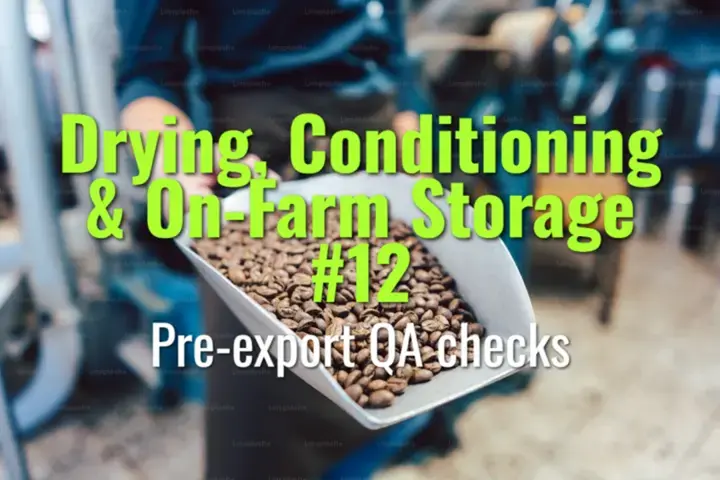Pre-export QA checks
This topic explains the key quality assurance (QA) checks performed before coffee export, ensuring that lots meet international standards for safety, consistency, and flavor integrity.
- Coffee Basics Nerds
- 2 min read
Article 12 of 12 in Drying, Conditioning & On-Farm Storage/

Why Pre-Export QA is Important
- Coffee may have traveled through multiple post-harvest steps (drying, storage, milling).
- Pre-export checks safeguard quality, food safety, and buyer confidence.
- Prevents rejection at destination ports, which can be costly for producers.
Key QA Checks
1. Moisture & Water Activity
- Confirm moisture is 10–12% and water activity 0.55–0.65.
- Ensures stability during shipping.
2. Physical Inspection
- Screen size grading and density sorting confirmed.
- Defect count performed (SCA or ICO standards: e.g., <5 full defects/300g for specialty).
- Check for foreign matter (stones, sticks, husks).
3. Cupping Evaluation
- Pre-shipment samples roasted and cupped by certified Q graders.
- Flavor, body, acidity, and aftertaste assessed.
- Defects (phenolic, moldy, baggy) flagged for remediation.
4. Traceability & Documentation
- Lot codes matched to records of origin, processing, and storage.
- Certifications (Organic, Fairtrade, RA, etc.) verified.
- Export paperwork aligned with QA results.
5. Packaging & Bag Checks
- Verify integrity of jute or hermetic bags.
- Inspect for holes, contamination, or odor absorption.
- Pallets checked for cleanliness and fumigation compliance.
Remediation if Problems Found
- Re-cleaning via optical sorters or density tables.
- Re-drying if moisture too high.
- Re-cupping to confirm corrections.
- Segregating or downgrading lots if defects cannot be fixed.
Benefits of Pre-Export QA
- Ensures coffee arrives at buyers in stable, high-quality condition.
- Strengthens trust and relationships with importers.
- Reduces economic risk of rejections or discounts.
Lasting Importance
Pre-export QA checks act as the final safeguard in coffee’s post-harvest journey. By systematically verifying physical, sensory, and safety standards, producers and exporters secure market access and protect the reputation of their coffee.
You might also like:
- Tags:
- Lasting Importance
- Food Safety
- High Quality
- Water Activity
- Screen Size
- Lot Codes
- Post Harvest
- Producers Exporters
- Organic Fairtrade
- Safety Standards
- Coffee Arrives
- Certifications Organic
- Hermetic Bags
- Market Access
- Drying Storage
- Moisture Water
- Ensures Coffee
- Foreign Matter
- Defects Phenolic
- Origin Processing
- Pre Shipment
- Processing Storage
- Body Acidity
- Flavor Body
- Buyer Confidence
- Physical Sensory
- Safeguard Quality